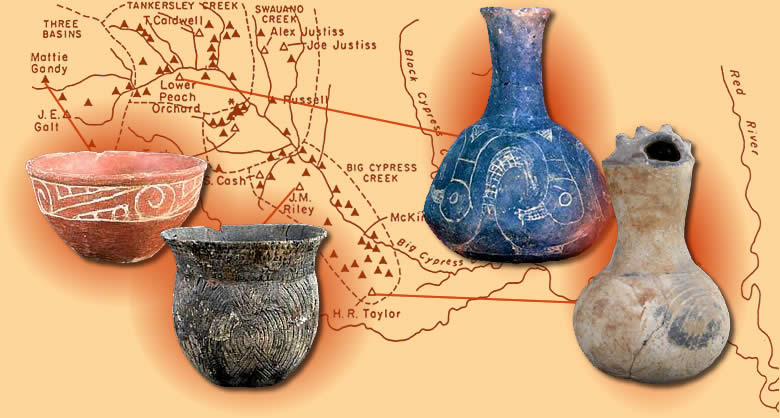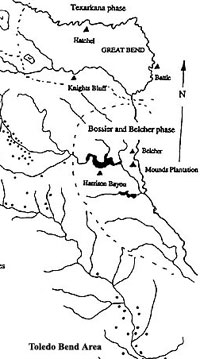
Distribution of Titus phase sites.
From Perttula, 1998.
Click images to enlarge
|
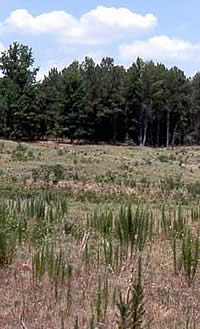
Titus phase settlements are sometimes found on upland
ridges protruding into the floodplains of the major and
minor streams. This example is near Benson's Crossing,
Big Cypress Creek, Titus County, Texas. TARL archives. |
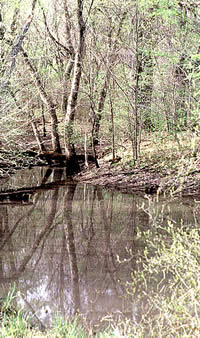
Wooded bottomland along Cooper Creek, a tributary of the
South Sulphur River. This was near the western edge of
the area within which the Titus phase is found. The Blackland
Prairie to the west of the Cross Timbers formed the western
periphery of the Caddo Homeland. Photo by Bill Martin. |

Plan of the Ear Spool site, a Titus
phase hamlet in Titus County. Three circular houses
were uncovered on one side of a small plaza. On the
opposite side was a "special building" with
an extended entranceway and supports for interior benches.
There were several burials, one inside a house. Courtesy
PBS&J.
|
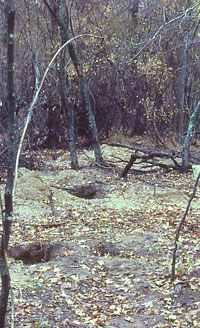
Looted Titus phase cemetery in Marion
County. Photo by Tim Perttula.
|
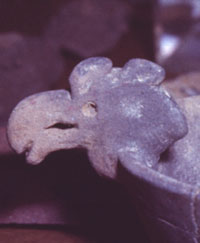
Turkey vulture effigy "tail-rider"
bowl, probably a trade piece from the Frankston phase
area, from looted Titus phase cemetery in Big Cypress
Creek drainage.
|
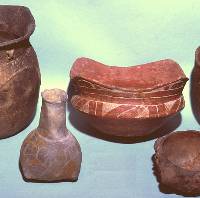
Titus phase pottery from cemetery
at the Russell site. The red Avery Engraved bowl in
the middle is probably a trade piece from the McCurtain
phase area in the Red River Valley to the north. TARL
archives.
|
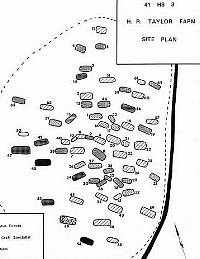
Plan of a Titus phase community cemetery (about A.D. 1600-1700)
at the Taylor Farms site near Lake O' the Pines within
the valley of Big Cypress Creek in northeast Texas. The
University of Texas excavated this site in 1931 and documented
64 graves. Note the consistent east-west grave orientation
and the fact that the graves do not intrude into one another. |
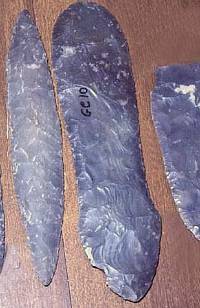
Large, thin chipped-stone knives
like these are found in Titus phase burials thought
to be those of high-status adult males. These examples
are from looted burials in the Big Cypress Creek drainage.
Several of these (if not all four) appear to be made
of Edwards chert from central Texas.
|
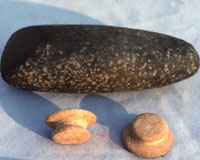
Celt (ground stone axe head) and
a pair of stone ear spools from Titus phase burial,
Lower Peach Orchard site, Camp County. TARL archives.
|
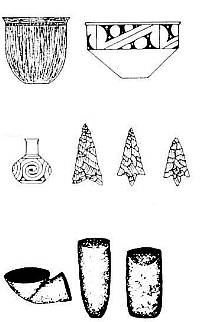
Typical Titus phase artifacts.
|
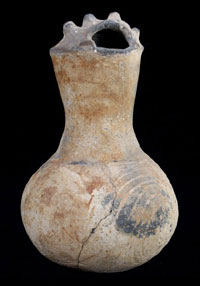
Taylor Engraved bottle with highly
unusual "spiked gaping mouth." Titus phase,
Taylor Farm site, Harrison County, Texas, height = 15.5
cm. TARL collections.
|
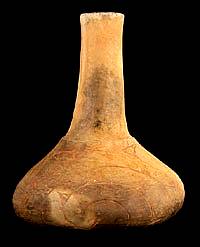
Wilder Engraved bottle, Titus phase,
Mattie Grandy site, Franklin County, Texas, height =
20.9 cm. TARL collections.
|
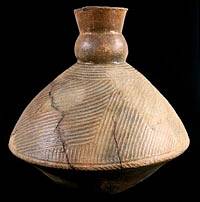
Keno Trailed bottle, Titus phase,
Taylor Farm site, Harrison County, Texas, height = 21
cm. TARL collections.
|
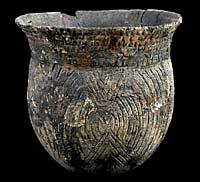
LaRue Neck Banded jar, Late Caddo,
ca. A.D. 1400-1650, J. M. Riley site, Upshur County, Texas,
height = 16.5 cm, diameter = 15.3 cm. TARL collections.
|
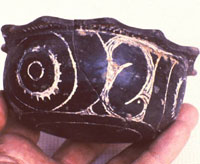
Ripley Engraved bowl with kaolin-filled
S-shaped scroll design. Shelby site, Camp County, Texas.
Courtesy Dee Ann Story.
|
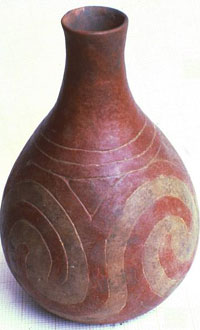
Polished red bottle with negative
engraved scrolls. A very similar bottle is known from
the Hatchel site (41BW3) on the Red River, and this
vessel may have been traded from the Red River Caddo
to the Titus phase Caddo living the Shelby site. Courtesy
Dee Ann Story.
|
|
The archeological traces of Caddo groups who
lived between the Sabine and Sulphur rivers in the East Texas
Pineywoods between about A.D. 1430-1680 are known as the Titus
phase. Of the several hundred identified sites with Titus
phase occupations, the largest concentration occurs in the
Cypress Bayou (or Big Cypress Creek) Valley. Other Titus phase
sites are found throughout the valley of the Little Cypress
Creek, the southmiddle portions of the Sulphur River basin,
the middle and upper portions of the White Oak Creek drainage,
and the upper and middle reaches of the Sabine River drainage.
Closely related communities were present in the Toledo Bend
area farther to the south along the Sabine River in Louisiana
and Texas and probably represent a late movement of Titus
phase people.
Archeologist Pete Thurmond sees the Titus phase
has being made up of four contemporaneous subclusters: the
Three Basins, Tankersley Creek, Swauano Creek, and Big Cypress
Creek. In addition, Robert Turner has proposed early and late
periods within the Titus phase based on design motif variations
on Ripley Engraved carinated bowls and changes in vessel form.
Combining both ideas, there are apparent geographical clusters
within the Titus phase as well as noticeable changes through
time.
Thurman defined his subclusters based on differences
in the design motifs found on the most common type of decorated
Titus phase pottery, Ripley Engraved bowls, as well as differences
in other shared pottery types, and the distribution of different
arrow point styles across the area. He argues that the Titus
phase subclusters represent separate tribes or subtribes similar
to the named groups who made up the historically known Hasinai
and Cadohadacho alliances. The overall Titus phase seems to
represent the archeological remains of a series of tribes/groups
banded together in an alliance analogous to, and at least
partially contemporaneous, with that of the Hasinai to the
south and the Kadohadacho to the northeast.
In general, Late Caddo societies seem to have
had a three-tier social/political hierarchy. At the top were
civic-ritual centers that had platform (temple) mounds, burial
mounds, and presumably the residences of principal leaders
(caddis as well as the xinesi and lesser priests). The larger
examples of these are found along the major stream valleys,
such as the Red, Ouachita, and Little rivers, but smaller
centers were also present in smaller drainages such as along
Big Cypress Creek (Titus phase). Below the civic-ritual centers
(in size and presumably status) were small mound centers that
lacked burial mounds or large platform mounds. Instead they
had small mounds that capped burned and ritually dismantled
structures functionally equivalent to those found on the platform
(temple) mounds at the larger centers. At the bottom of the
social ladder were small but widely distributed rural communities
made up of many farmsteads and hamlets often spread out along
smaller streams and across productive upland areas.
For the Titus phase, Thurmond recognized three
types/sizes of settlements: limited use areas, small settlements,
and large settlements. The limited use areas are places that
were used only in certain seasons for short-term stays such
as camps for hunting, nut-gathering, and salt-making. In contrast,
the small and large settlements were occupied year-round.
Small settlements (between 0.2-1.8 hectares or 0.5-4.5 acres
in size) account for 73 percentage of the known Titus phase settlements
in the Cypress Creek basin, the limited use areas 23 percentage, and
the large settlements (those larger than 1.8 hectare or 4.5
acres) only 4 percentage of the sample.
One of the more intensively investigated large
Titus phase settlements is the Pilgrim's Pride site along
Big Cypress Creek at its confluence with Walkers Creek. Residential
areas at the site cover between 5-10 acres, with more than
100 pit features, several circular structures, midden deposits,
and more than 20 burials, along with an open plaza-like area.
Several of the burials appear to have been placed in and near
the floors of structures, but the Pilgrim's Pride site also
had a planned cemetery with at least 19 burials.
The small settlements appear to have been home
to one or several family compounds marked today by scattered
house middens often containing daub (fired clay) and trash-heap
(midden) mounds. Midden mounds up to one meter in height were
common on Titus phase settlements before they began to be
plowed in historic times. Excavations suggest that many activities
occurred outside the houses, resulting in trash-filled pits,
hearths, and posts in these areas, where ramadas and granaries
may also have been present, along with concentrations of artifacts
and debris. The limited evidence of structure rebuilding,
suggests that most Titus phase settlements were occupied only
about a generation. Small family cemeteries typically occurred
nearby.
Because of the intense avocational and professional
and focus on the cemeteries that occur on Titus phase settlements,
as well as significant looting of these sites since the early
20th century, little is known about the types of houses and
storage structures used by these groups. Based on the few
houses that have been excavated (some of which were in mounds
and probably are not ordinary domestic structures), houses
were probably circular in shape, with wattle and daub walls
(sometimes) and thatched roofs. They were between five and
eight meters in diameter and some, especially those capped
by mounds, have extended entranceways. Within the houses were
central hearths and center posts, possible interior benches
and racks for sleeping and storage, as well as storage and
trash pits. Residential structures had some midden accumulation
on their floors (i.e., house middens), which were not prepared
or clay-lined, but the vast majority of the daily trash and
refuse was deposited on the nearby trash midden mound.
When Pedro Vial visited the Nadaco Caddo "village"
near the Sabine River in 1788 (probably in the vicinity of
Longview and Marshall, Texas), he described it as having thirteen
to fifteen houses scattered over a distance of three leagues
(about eight miles). The houses or ranchos of the Nadaco were
evidently distributed mainly along tributaries of the Sabine
River. The distribution of Titus phase settlements suggests
that agricultural farmsteads and hamlets were scattered similarly
in prehistoric times, usually being found near springs or
along smaller streams, where good soil and fairly level ground
for farming was present.
The permanent settlements and larger cemeteries
of the Titus phase tend to be found near springs. In contrast,
Late Caddo mound centers typically do not occur in proximity
to a spring, but rather are on the floodplains of major rivers
and large creeks or they are situated on ridges that jut into
and overlook large floodplains.
Mound-building in the Late Caddo period in the
Pineywoods outside of the Red River valley was once thought
to have ceased between roughly A.D. 1400 and 1500, but dates
from several sites in Upshur and Camp counties suggest mound-building
may have continued in the Titus phase "heartland"
until about A.D. 1600 or later. Only a modest number of Late
Caddoan period mounds are known in the region, ranging from
one to four small mounds per site.
There are two types of cemeteries used by the
Titus phase groups: the small family cemetery, and the large
community cemetery. More than 130 Titus phase cemeteries have
been documented to date.
The small family cemeteries contain roughly
equal numbers of adult males and females and are located near
farmsteads or hamlets. Such cemeteries in the western margins
of the Titus phase area have about 10-20 individuals while
those in the Titus "heartland" along Big Cypress
bayou have 20-40 graves. There are few indications of differential
status or social rank in grave good associations and burial
treatment in family cemeteries. Typically, the graves are
laid out in rows with the individuals in extended positions
oriented roughly east-west. Children were typically buried
in subfloor pits within the houses themselves. Artifact associations
in family cemeteries seem to differ only by age and sex. Older
individuals are buried with more offerings than younger ones.
Men's graves often contain clusters of arrow points in patterns
suggesting quivers of arrows. Women's graves contain polishing
stones or more numerous pottery vessels. Items of exotic material
are quite rare in family cemeteries.
The large community cemeteries of the
Titus phase seem to have served several communities in the
vicinity. These cemeteries usually contain at least 60-70
individuals, but some are known that contained at least 150-300
individuals. Large community cemeteries show the existence
of different social classes within the Titus phase Caddo communities.
Known community cemeteries are not uniformly distributed among
the Titus phase groups, but are concentrated on Big Cypress
Bayou and several of its eastward-flowing tributaries (i.e.,
Walkers Creek, Dry Creek, Greasy Creek, Meddlin Creek, and
Arms Creek), the Titus phase "heartland," with a
few large cemeteries known on Little Cypress and White Oak
creeks. Presumably, the areas where these larger cemeteries
are found had the highest population densities and more complex
societies.
The larger community cemeteries are internally
organized by space and structurally divided by rank. Graves
rarely overlap and it looks like the cemeteries expanded over
time. Since the cemetery plan was consistently maintained,
they may reflect stable communities over several generations.
Four criteria have been used to identify social
status ranking in Titus phase cemeteries: the presence of
large shaft tombs, the number of individuals per grave, the
relative quantity of grave goods, and the presence of certain
types of presumed high-status artifacts. Large shaft tombs
and those with multiple interments are considered to be high-status
burials; all other Titus phase burials are single, individual
burials. Family cemeteries do not contain shaft tombs or multiple
interments. The high status burials also contain larger numbers
of grave offerings ( over 30 compared to an overall average
of about 15 per grave) than those of other burials. There
are also certain types of artifacts only found in high-status
burials. For example, in the Cypress and Upper Sabine basins,
large, thin chipped-stone knives are almost always found with
high status adult males.
There are 18 known Titus phase sites in the
Pineywoods that have burials of presumed high-status individuals,
such as J. E. Galt, Caldwell, Lower Peach Orchard, Tuck Carpenter,
H. R. Taylor, and others; these are along Big Cypress Bayou
and its tributaries, particularly in the Titus phase "heartland"
between the dam site at Lake Bob Sandlin and the Lake O' the
Pines dam, and western and southern tributaries such as Dry
Creek, Greasy Creek, and Arms Creek. Other cemeteries with
high rank burials occur in the Little Cypress Creek valley,
along a Sabine River tributary, and on White Oak Bayou. The
best-known and studied community cemeteries with high-status
burials are the Tuck Carpenter and H. R. Taylor sites.
At the Tuck Carpenter cemetery, high-status
burials dating between ca. A.D. 1350-1550 are at the center
of the 70+ interments in the cemetery, while the latest high-status
burials (estimated to date after ca. A.D. 1550 to the early
1600s) were placed near the outer edge of the cemetery. With
the exception of the two graves with multiple interments,
graves contained single individuals in extended position that
were placed in the cemetery in roughly aligned north-south
rows. The high-status burials contained on average 37 grave
offerings per burial (large numbers of ceramic vessels and
arrow points), compared to about 15 grave goods per burial
for the cemetery as a whole.
A similar pattern is seen in the graves in the
cemetery at the H. R. Taylor site. Mean values of ceramic
vessels (8.3 per individual), arrow points (5.09 per individual),
and total number of specimens (14.5 per individual) as grave
offerings at H. R. Taylor are not significantly different
from other Titus phase cemeteries, but the high-status burials
each contained between 27-55 grave offerings.
High-status individuals account for 8 and 9 percentage
of the burials at H. R. Taylor and Tuck Carpenter, respectively.
Overall, in the Titus phase mortuary populations, high-status
individuals account for less than 2 percentage of all known burials,
showing that the community cemeteries were associated with
the mound centers where the leading members of the Titus phase
societies presumably lived. In contrast, lower-status interments,
namely those lacking grave goods or containing only small
quantities (0 to 9.0 items at Tuck Carpenter and 0 to 6.7
items at H. R. Taylor), account for 19 percentage and 23 percentage of the burials
at the two sites, respectively. As judged by the grave goods,
lower-status individuals at both these community cemeteries
were usually adult females, juveniles, or children. Most of
the individuals at both cemeteries, 73 percentage at H.R. Taylor and
68 percentage at Tuck Carpenter, fall within the middle category of
neither high nor low status.
The majority of known Titus phase burials of
apparent high-status appear to date after ca. A.D. 1550-1600.
Those individuals buried prior to A.D. 1550 demonstrate considerable
intra-regional variability in the manner of burial treatment,
as well as in the types of grave offerings. For example, in
addition to the multiple interments at Tuck Carpenter, shaft
tombs are represented in a pre-A.D. 1550 cemetery at the Lower
Peach Orchard site. At the J. E. Galt site, the high-status
burial included such offerings as a large number of celt fragments
and other native stone implements, rather than caches of arrow
points. Galt bifaces were also recovered from the cemetery.
In general, community cemeteries are relatively
short-lived phenomena that were used intensively in the core
Titus phase area in the basin of Big Cypress Creek after about
A.D. 1550 to the early 1600s. It is probably no coincidence
that the period of the most intensive use of community cemeteries
seems to be roughly contemporaneously with the initial contact
between Titus phase Caddo populations and the Spanish De Soto/Moscoso
entrada of 1542-1543. The short-term use of these cemeteries
could, in part, reflect deaths due to conflicts with the Spanish
army as well as increased mortality from European diseases.
The timing in the intensification of the use of large community
cemeteries in the region also seems to occur at about the
same time that mound centers ceased to be used for community
ritual and religious functions by about the 1550s or slightly
later. Collectively, the changes occurring after 1550 reflect
rapidly changing societies on the eve of (or in the process
of) group consolidation and the eventual Caddo abandonment
of the Pineywoods of northeast Texas.
One of the most striking aspects of the Titus
phase archeological record is the diversity and distinctiveness
of the pottery found in settlements and cemeteries. The wide
variety of vessel shapes and decorations, as well as their
frequency in domestic contexts, demonstrates the importance
of pottery for cooking and serving food, as personal possessions,
and as social identifiers. Large quantities of both fine wares
and utility wares were manufactured in the Titus phase.
The fine wares were tempered with finely crushed
grog (pottery) and bone, and were well-polished; shell-tempered
vessels are quite rare, and when found, are typically trade
wares from the Red River Caddo. Titus fine ware was decorated
with engraved lines, with scrolls, scrolls and circles, pendant
triangles, and other curvilinear motifs. Another form of decoration
was the application of a red hematite (ochre) slip on both
interior and exterior surfaces, and the painting of engraved
lines with red hematite or white kaolin. The diversity of
vessel forms is impressive: carinated bowls, compound bowls,
bottles, cone-shaped bowls, ollas, jars with flaring rims,
square bowls, globular peaked jars, and chalices. Animal effigies
and rattle bowls were also made.
The utility vessels were tempered with grog
and grit (crushed stone such as sandstone and hematite), and
had a coarser paste along with a thicker body. Small to large
jars (over 30 centimeters or 12 inches in height with mouth
diameters greater than 25-30 cm) and plain conical bowls were
typical utility vessel shapes. The presence of carbon encrustations,
food residues, and sooting on many of the utility vessels
show clearly that these were cooking pots. The larger utility
vessels were probably mainly used for storage of food (wide/flaring
mouths) and liquids (narrow/constricted mouths).
Utility vessels were decorated and textured
with neck-banding, brushing, applique, incising, punctating,
and various combinations thereof. Small handles or lugs were
added to some utility vessels. Utility vessels probably comprised
between 50 to 70 percentage of the ceramic assemblages in Titus phase
settlements. Far fewer utility vessels, proportionally, are
found in Titus phase cemeteries.
Titus phase groups also made ceramic earspools,
as well as tubular and elbow pipes of clay. Earspools were
also made from siltstone and sandstone, as well as wood. One
set of earspools from the Tuck Carpenter site had been covered
with sheet copper. The elbow pipes are commonly decorated
with engraved lines that have been painted (filled) with red
hematite or white kaolin clay.
Compared to earlier periods, stone tools and
tool-making debris are generally uncommon at Late Caddo period
sites in the Pineywoods. We suspect this is because many tools
were made out of wood, cane, bone, and shell, few examples
of which are preserved in the archeological record. The relatively
few stone tools types present also indicate the increased
importance of other materials at the expense of stone. Common
stone tools include triangular and corner-notched arrow points,
flake tools (drills, scrapers, and retouched pieces), along
with an array of groundstone implements. These include celts,
metates and manos, battered and polished cobbles and pebbles,
hematite and limonite pigment stones, and abrading slabs.
Although bone is usually poorly preserved in
Titus phase sites, many different kinds of bone tools have
been found in favorable contexts. Among these are deer-mandible
cutting tools, deer beamers (hide-working tools), deer ulna
punches, antler-tine flaking tools, and deer and bird bone
pins. Turtle carapace rattles have also been found. Heavy
clam shell digging tools ("hoes") are sometimes
present.
Unfortunately, few studies have been done of
the diet of Titus phase groups based on charred plant and
animal remains, which are sometimes reasonably well preserved
in middens, hearths, and pit features. Charred plant remains
from trash midden deposits suggests that corn (Zea mays L.)
was the main dietary staple, but that beans (Phaseolus
vulgaris) were also an important food source. Nuts and
seeds were still gathered, but of lesser importance in the
Titus phase than they were between ca. A.D. 900-1400. In fact,
evidence from the Titus phase in the Pineywoods, as well as
elsewhere in the Caddo area, suggests that the Late Caddo
economy was based primarily on maize (corn).
Animal bones identified in Titus phase trash
middens include deer, turkey, cottontail rabbit, jackrabbit,
squirrel, and beaver. Turtle and fish were also present, but
were relatively uncommon compared to mammals and birds. Deer
and turkey appear to have been the main prey species.
Although many of the details are not yet understood,
grave goods and other exotic artifacts (such as marine whelk/conch
shell and certain stones) suggest that trade among "town
and country" Caddo communities and among Caddo groups
in different areas was flourishing at the time of initial
European contact in the sixteenth century. Titus phase people
were also part of long-distance trade and information networks
linking Caddo groups with farming peoples living in the Southwest,
Southern Plains, and lower Mississippi Valley.
The most common ceramic imports found in Titus
phase sites are those from the Red River Caddo groups. They
include such fine wares as Belcher Ridged, Belcher Engraved,
Glassell Engraved, and Hodges Engraved from the Belcher phase
to the east, and shell-tempered Avery Engraved and Simms Engraved
pottery types of the McCurtain and Texarkana phases to the
north some 100 kilometers (62 miles). Red River gravel chert
(flint) and chalcedony was found to make up about 20 percentage of the
stone tools and debris in the Three Basin subcluster of the
Titus phase. Hatton tuff and siliceous shales from the Ouachita
Mountains were used to make celts. Edwards chert from central
Texas is also found in Titus phase sites, showing the existence
of trade and exchange with non-Caddoan hunting and gathering
peoples living more than 150 kilometers (93 miles) to the
west and southwest of the Pineywoods Caddo.
New assessments of the route of the de Soto-Moscoso
1542-1543 entrada through East Texas suggest that the Spanish
encountered the Titus phase peoples described by the chroniclers
as the Lacane province. By 100-150 years later, the Titus
area had been virtually abandoned. The demise of the Titus
phase people is thought to be mainly due to the introduction
and, more importantly, the continued exposure of Caddo groups
to European epidemic diseases. It is likely that some Titus
phase peoples moved to live with either the Red River Kadohadacho,
or among the Hasinai Caddo south of the Sabine River.
Archeologists believe that Titus phase Caddo
sites in the Pineywoods hold great promise in helping to document
the nature of social, political, demographic, and economic
changes in the region during a most eventful era in Caddo
history. In part this is because improved dating now makes
it possible to use subtle pottery differences to pin down
the date of some sites and events (such as graves) to perhaps
within a 20- to 30-year period. As other studies of Caddo
archeology make clear, there have been substantial changes
in Caddo societies from ca. A.D. 800 to European contact.
One of the most important changes is the development and elaboration
of complicated forms of social and political organization
after ca. A.D. 1400 in many regions of the Caddo Homeland.
|
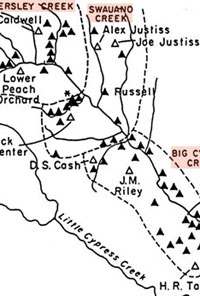
Titus phases subclusters as defined
by Pete Thurmond. From Perttula, 1998.
|
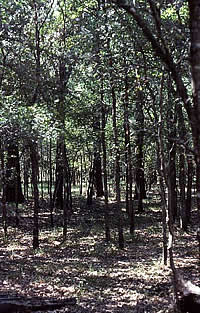
The bottomlands along Big Cypress Creek and its many tributaries
were rich sources of wild plant foods, wood, and game
for Titus phase peoples. Titus County, Texas. TARL Archives. |
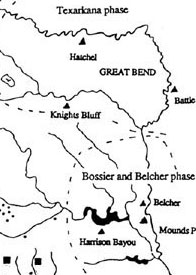
Distribution of known Titus phase
mound centers; most, as can be seen, occur along Big
Cypress Creek. Adapted from Perttula, 1998.
|
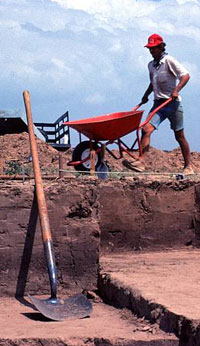
Archeologists at work at the Benson's
Crossing site, a Middle Caddo period site near Big Cypress
Creek that probably represents the direct ancestors
of Titus phase people. The two-tone soil colors in the
excavation walls represent a dark midden deposit overlain
by a lighter colored plow-disturbed zone. TARL archives.
|
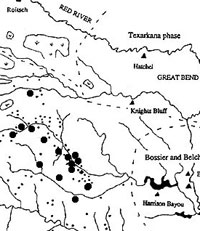
The distribution of large Titus phase
cemeteries is similar to that of Titus phase mound centers;
the two are obviously related. Adapted from Perttula,
1998.
|
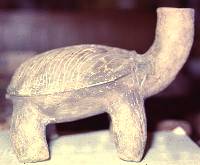
Turtle effigy bottle from looted
Titus phase cemetery in Big Cypress Creek drainage.
|
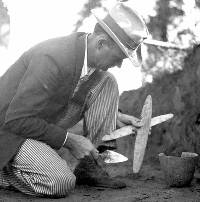
A.T. Jackson holds two large, thin
chipped-stone knives found in a Titus phase cemetery
at the J. E. Galt farm in Franklin County during excavations
by the University of Texas in 1931. These "Galt
bifaces" could be more accurately described as
ceremonial knives or blades and, although no bones were
found, the knives were almost certainly offerings in
a high-status grave. TARL archives.
|
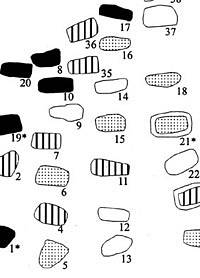
Plan of Titus phase community cemetery
(A.D. 1350-1600) at the Tuck Carpenter site located
on a tributary of Big Cypress Creek in Camp County,
Texas. Avocational archeologists and collectors excavated
this cemetery in the 1960s; 44 of the estimated 70+
graves were documented.
|
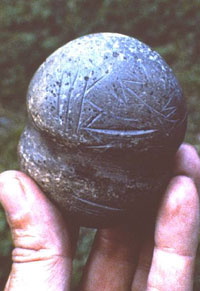
Grooved and decorated mace head,
probably from a high-status burial. Shelby site, Camp
County, Texas. Courtesy Dee Ann Story.
|
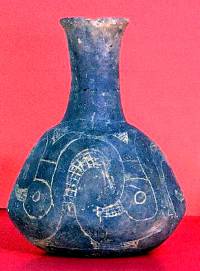
Engraved bottle with engraved bird
motif, Titus phase burial, Lower Peach Orchard site,
Camp County, Texas. TARL archives.
|
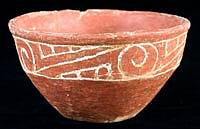
Ripley Engraved bowl, Titus phase,
Mattie Grandy site, Franklin County, Texas, height =
9 cm, TARL collections.
|
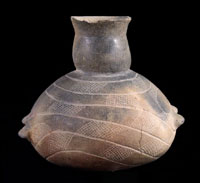
Hodges Engraved bottle with unusual
oblong form and pairs of nodes at both ends. Titus phase,
Taylor Farm site, Harrison County, Texas, height = 13.8
cm. TARL collections.
|
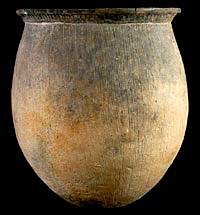
Karnack Brushed jar, Titus phase,
Taylor Farm site, Harrison County, Texas, height = 27.5
cm. TARL collections. Click on image for enlarged view.
|
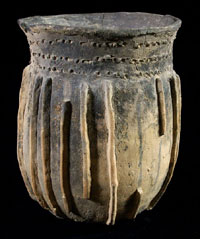
Cass Appliqué jar, Titus phase,
Morris County, Texas, height = 17.6 cm. TARL Collections.
Click on image for enlarged view.
|
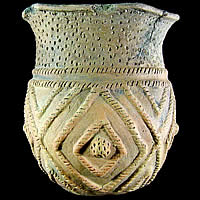
Harleton Appliquéd Jar, Titus
phase, Taylor Farm Site, Harrison County, Texas, height
= 10 cm, TARL collections.
|

Compound engraved bowl with unusual
(kaolin-filled) scroll motif. Shelby site, Camp County,
Texas. Courtesy Dee Ann Story.
|
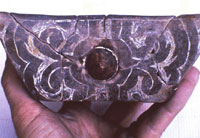
Four-sided square bowl with unique
scroll motif and a protruding node or appendage, a rare
form of decoration on Titus phase vessels. Shelby site,
Camp County, Texas. Courtesy Dee Ann Story.
|
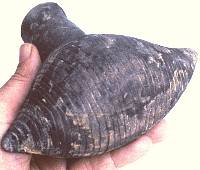
Unique bottle with trailed design.
Shelby site, Camp County, Texas. Courtesy Dee Ann Story.
|
|
